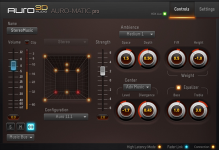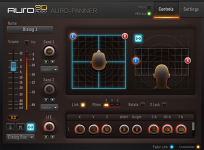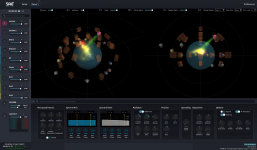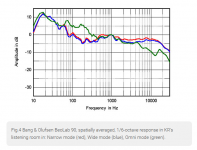Regarding spaciousness and envelopment: In his book, Floyd Toole states that envelopment is one of the two components of "Spaciousness or spatial impression" (the other being image size/position). He says of envelopment:
Dr. David Griesinger gives lots of detailed information in this paper.
[...] this is the impression of being in a specific acoustical space. It is perhaps the single most important perceived element distinguishing truly good concert halls. It is the one thing I hear at my regular live concert hall experiences that simply is not replicated at home without multichannel audio delivering independent greatly delayed sounds from different directions.
Dr. David Griesinger gives lots of detailed information in this paper.
Last edited:
So they basically suggested that, ideally, one would have different loudspeakers (with different in-room response shapes) for near-field and far-field recordings. That's a strange reasoning to me. Maybe from the spaciousness / imaging preference standpoint (different DIs), but a spectral balance? Why would they do it on the loudspeaker side and not in the recording? Well, it was 1974 - before I was born, so what do I know 🙂
Go and listen to the Beolab 90.
The ability to vary the beamwidth will make you wonder how you lived your entire life without this feature.
Sean Olive's work showed a large body of test subjects expressed a preference to the entire bandwidth having a downward tilt of no more than 4db(+/- 3db) across a decade (or 20hz to20khz) which does not mean much when compared to flat.
It doesn't seem like much, but the difference is clearly discernible.
Besides, other, more extreme target curves exist, like -6 dB down at 20 kHz.
Regarding spaciousness and envelopment: In his book, Floyd Toole states that envelopment is one of the two components of "Spaciousness or spatial impression" (the other being image size/position). He says of envelopment:
[...] this is the impression of being in a specific acoustical space. It is perhaps the single most important perceived element distinguishing truly good concert halls. It is the one thing I hear at my regular live concert hall experiences that simply is not replicated at home without multichannel audio delivering independent greatly delayed sounds from different directions.
This implies multi-channel recordings, doesn't it?
In my - admittedly limited - experience, most multi-channel releases of live events or studio recordings are clearly inferior to the stereo versions.
Therefore, I have never felt the need for multi-channel audio. For (home) cinema it is of course a completely different story.
Last edited:
Yes, Toole is a big advocate of multichannel and views stereo as antiquated and inferior. For playback of stereo material he usually employs "tasteful upmixing", which he defines as "leaving the stereo soundstage alone and adding enveloping information that is deficient in stereo". In the past he used Lexicon's Logic7 (designed by David Griesinger), but that algorithm isn't commonly available in modern processors so he uses the Auro Technologies upmixer (Auro-Matic) now (as far as I know, anyway...).
Last edited:
The Griesinger paper is definitely worth reading.
In this thread downward sloping response curves are discussed, including the differences between small and large rooms.

In this thread downward sloping response curves are discussed, including the differences between small and large rooms.

Last edited:
Yes, Toole is a big advocate of multichannel and views stereo as antiquated and inferior. For playback of stereo material he usually employs "tasteful upmixing", which he defines as "leaving the stereo soundstage alone and adding enveloping information that is deficient in stereo". In the past he used Lexicon's Logic7 (designed by David Griesinger), but that algorithm isn't commonly available in modern processors so he uses the Auro Technologies upmixer (Auro-Matic) now (as far as I know, anyway...).
This is an example of what's called "immersive audio technologies". Auro also supplies plugins for Pro-Tools a.o.
I've some experience with Spat (last image).
So much for being OT.
Attachments
Last edited:
Sean Olive's work showed a large body of test subjects expressed a preference to the entire bandwidth having a downward tilt of no more than 4db(+/- 3db) across a decade (or 20hz to20khz) which does not mean much when compared to flat.
It's really per decade (3 - 4 dB/decade). 20-20k are three decades and that makes around 10 dB for the whole band. Your picture above shows that clearly.It doesn't seem like much, but the difference is clearly discernible.
Besides, other, more extreme target curves exist, like -6 dB down at 20 kHz.
That's what I said - they change DI in the first place. But do they also vary SP curve? Is the LW flat in each case? That would be interesting to learn.Go and listen to the Beolab 90.
The ability to vary the beamwidth will make you wonder how you lived your entire life without this feature.
Here's some information on the Beolab 90:
[1] B&O Tech: Intuitive Directivity Plots – earfluff and eyecandy
[2] B&O Tech: Intuitive Directivity Plots v.2 – earfluff and eyecandy
[3] Bang & Olufsen BeoLab 90 loudspeaker Measurements | Stereophile.com
[1] B&O Tech: Intuitive Directivity Plots – earfluff and eyecandy
[2] B&O Tech: Intuitive Directivity Plots v.2 – earfluff and eyecandy
[3] Bang & Olufsen BeoLab 90 loudspeaker Measurements | Stereophile.com
Thanks. This graph is probably the closest to what I'd like to know -
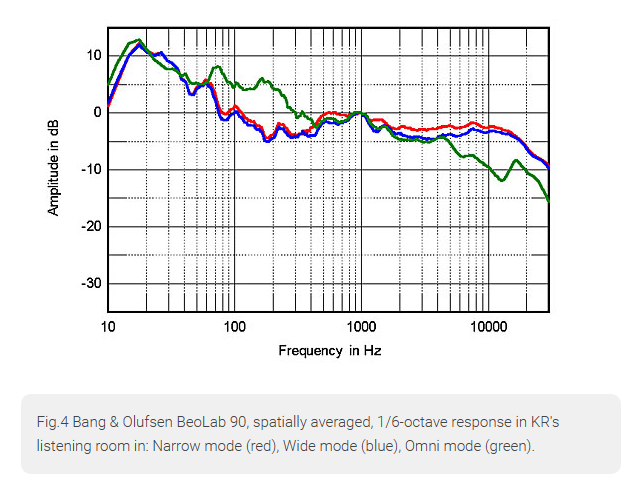
Hmm. None of the curves is something I would especially strive for. The omni setting seems just crazy. Doesn't this loudspeaker sound best in the narrow mode anyway? 🙂
(Must admit, I've never heard these.)
Hmm. None of the curves is something I would especially strive for. The omni setting seems just crazy. Doesn't this loudspeaker sound best in the narrow mode anyway? 🙂
(Must admit, I've never heard these.)
Attachments
Yes, Toole is a big advocate of multichannel and views stereo as antiquated and inferior. For playback of stereo material he usually employs "tasteful upmixing", which he defines as "leaving the stereo soundstage alone and adding enveloping information that is deficient in stereo". In the past he used Lexicon's Logic7 (designed by David Griesinger), but that algorithm isn't commonly available in modern processors so he uses the Auro Technologies upmixer (Auro-Matic) now (as far as I know, anyway...).
Thanks for that. Is processing what David is suggesting when he talks of speakers to the sides potentially giving better envelopment? It's not something that can be achieved with two channel stereo? I ask because I've found I often get more "envelopment" when my listening position is more between the speakers.
Yes. Or extra discrete channels. Having a wider angle between the speakers (I'm assuming this is what you mean) may increase envelopment, but causes other problems (degradation of the phantom center image, for example).
From my reading of his work, you need sufficiently delayed (>150ms), decorrelated, lateral energy to produce envelopment below 1kHz or so. Two loudspeakers at ±30° in a small room cannot do this very well.
From my reading of his work, you need sufficiently delayed (>150ms), decorrelated, lateral energy to produce envelopment below 1kHz or so. Two loudspeakers at ±30° in a small room cannot do this very well.
Maybe it is distorsion that prevent us from going flat. Both recorded and reproduced. If we could reduce it to say < 0,01% THD & IM (anything) - it would perhaps be OK? I bet that this situation has never happened at realistic replay level....
//
//
Last edited:
Yes, that's what I mean. I was interested in ITD and then saw his presentation on ITD fluctuations and speakers at +/- 90 degrees.
I don't think this is a likely explanation. Look at the low frequencies - woofers distort like hell, yet listeners in general like it when this range is boosted up.Maybe it is distorsion that prevent us from going flat. Both recorded and reproduced. If we could reduce it to say < 0,01% THD & IM (anything) - it would perhaps be OK? I bet that this situation has never happened at realistic replay level....
//
I would think this has nothing to do with nonlinear distortion. This is really only a matter of a global EQ we are talking about now. This can be applied anywhere in the chain, including the digital data stored somewhere. Still this seems more like a historical habit (given by the widely available technology) than anything else to me.
Last edited:
Maybe not - we will find out if such system is ever realised.
Where the drawing I attached usable? No stress of course what so ever.
//
Where the drawing I attached usable? No stress of course what so ever.
//
Again, when you make a recording of a jazz band, for example, even without knowing a bit about the particular SPL curves of the monitors used, you will be able to mix the record so that it sounds natural ON THAT SPEAKERS (and in that room of course). Whether are they flat (let's say they are) or falling -3 dB/decade is completely irrelevant.
Then if someone listens to that recording on flat speakers (and in about the same room), it will sound natural to her/him, no mater that the response of the speakers is flat per se. That's completely unrelated.
Then if someone listens to that recording on flat speakers (and in about the same room), it will sound natural to her/him, no mater that the response of the speakers is flat per se. That's completely unrelated.
Last edited:
If something like this would universally be used it would of course impact the whole complex.
Neumann Introduces Automatic Studio Monitor Alignment Solution Jointly Developed with Fraunhofer IIS | audioXpress
//
Neumann Introduces Automatic Studio Monitor Alignment Solution Jointly Developed with Fraunhofer IIS | audioXpress
//
Sure, and that's the pain - no such standard exists to this day (as Earl mentioned). We are stuck with the "preferred" PIR so that when you make a flat DI speaker (to better match the specta of early reflections), you still have to tilt the response to sound more natural. Just because most recordings are made that way.
Last edited:
- Home
- Loudspeakers
- Multi-Way
- Acoustic Horn Design – The Easy Way (Ath4)
